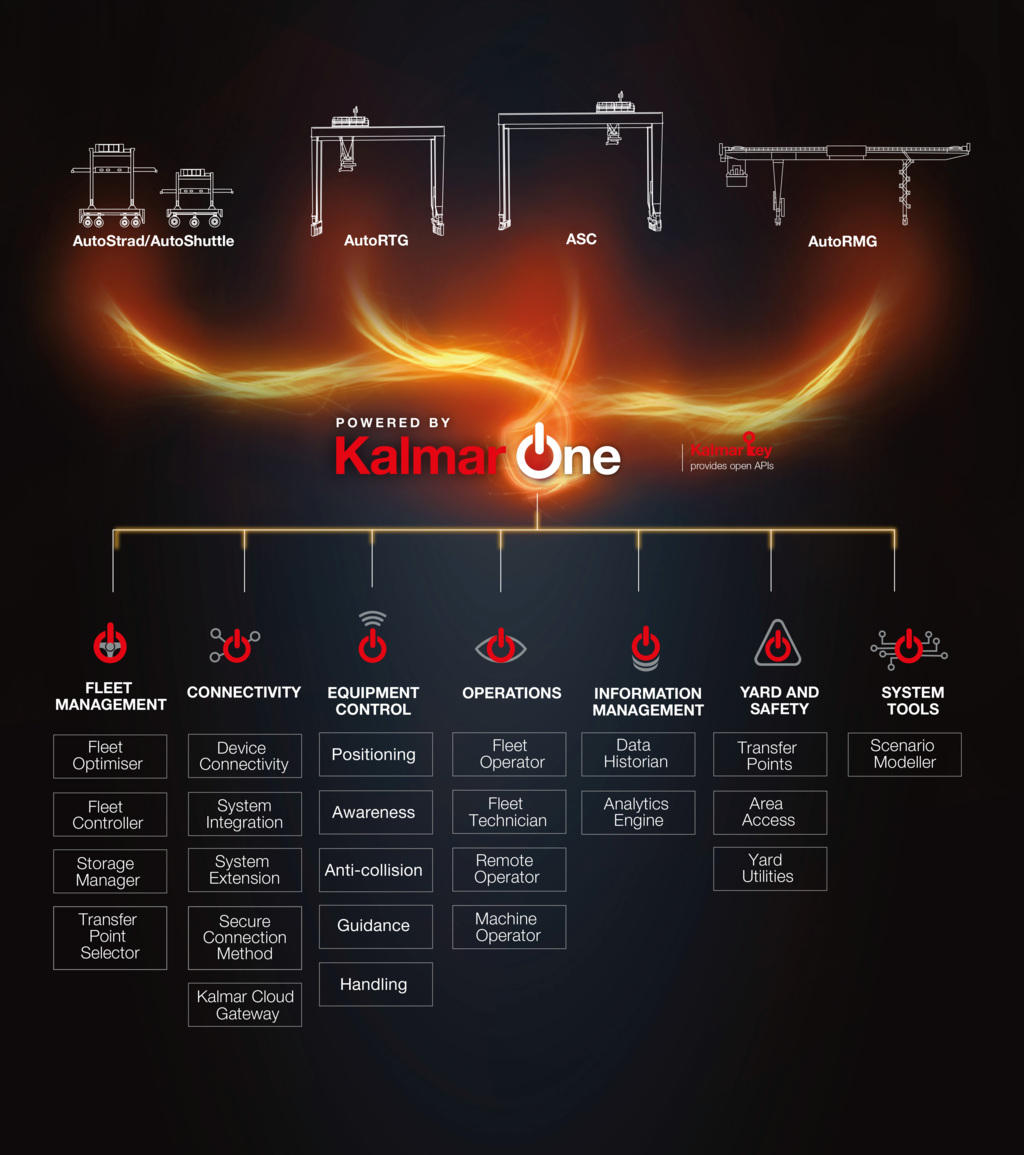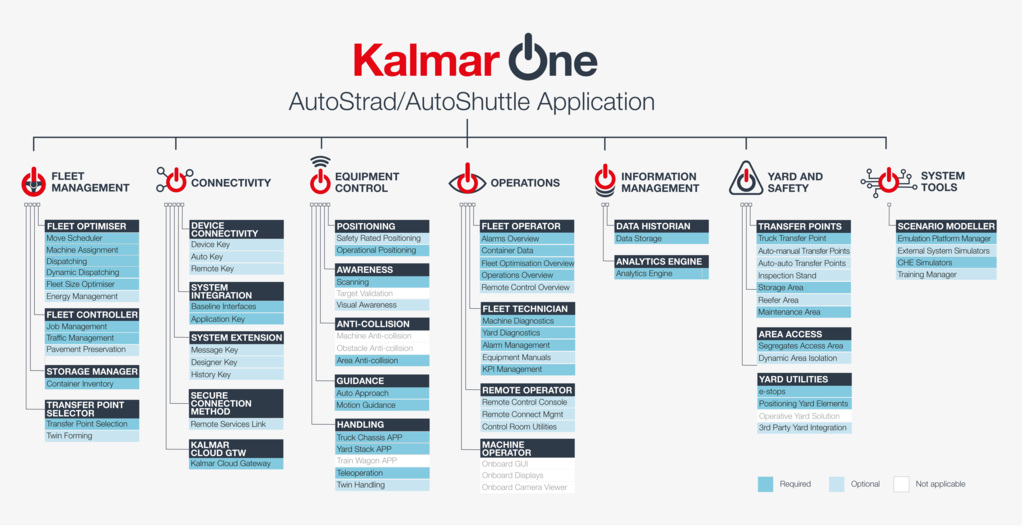In order to reap the full potential benefits of container terminal automation, a systemic, standardised approach is required. A key element is the availability of open application interfaces that enable terminal operators to customise their automation deployments, allowing third-party developers to provide offerings that are interoperable with the automation system. These additional software interfaces supplement the application-independent core software components of the terminal automation system and significantly extend its capabilities.
When combined with support services and third-party developers, an open automation platform enables robust and diverse business ecosystems that provide new opportunities for terminal operators, independent developers and automation system providers. Ultimately, terminal operators will have a broader range of capabilities to develop their systems with agility, based on their individual business processes and needs.
Industry standardisation is crucial
In order for terminal automation to develop to the next level in deployment speed and operational efficiency – and for operators as well as other industry players to be able to benefit from this development – a significantly higher level of standardisation is required.
In the past, a major challenge for most terminal automation projects was that many design and implementation questions had to be solved anew each time. These questions range from basic connectivity and equipment functionality to user interfaces and safety guidelines. With terminal operators unsure of the exact specifications needed for a terminal automation deployment, system providers have often needed to ”reinvent the wheel” for each customer case.
A markedly different situation can be seen in general process automation. Initially, each manufacturer developed closed systems with unique interfaces for their equipment, but over the decades, the industry converged on a set of interfaces that enable seamless connectivity with standardised technology. This development shifted the competitive focus of automation technology providers away from low-level interfaces and towards higher-value automation systems. Once the connectivity is standardised, diverse industry players can come together to create robust ecosystems that further develop the capabilities of their equipment and software applications.
TIC4.0 holds promise
Over the last year or two, the container shipping industry has been making some strides towards a common, shared approach for determining the key standards needed for terminal automation. The two key organisations working in the field are the Port Equipment Manufacturers’ Association (PEMA), and the newer Terminal Industry Committee 4.0 (TIC4.0), an open industry initiative established in 2020 whose members include both terminal operators and system providers.
TIC4.0 has a significant mission in developing the required standard sets for the container handling industry. The association released an introductory white paper and its first set of definitions in May 2021. These definitions serve as the low-level building blocks for further industry standards, laying out the basic terminological, grammatical and semantic framework for the standardised interoperability of automated container handling.
The task undertaken by TIC4.0 is significant in scope, requiring a specific and unambiguous way of defining the required concepts irrespective of the level of technology used in a terminal. Basic examples include providing definitions such as what constitutes a “container move”. These terms have previously been used and understood routinely in everyday language, but they have lacked the rigorous definitions required for unambiguous communication, valid performance measurement and seamless system interoperability.
Despite the challenges remaining, TIC4.0 is a significant step towards achieving the acutely needed level of standardisation in the next few years, not least because the association has managed to bring together a wide range of industry players that include major equipment and system providers as well as leading port and terminal operators.
Terminal automation platform: What and why?
Until recently, container terminal automation has primarily been conceived as an ”add-on” to equipment investment, instead of a comprehensive end-to-end solution. Automation solutions have been assembled as one-off projects that have required extensive integration of diverse systems and solutions, often from several vendors.
At the same time, as terminal automation advances, the focus in industry deployments is shifting from a limited number of new greenfield sites to the automation of hundreds of existing container terminals. These brownfield projects require that the automation system can interface with diverse existing fleets and processes at widely differing levels of automation. To gain the maximum benefit of automation and to fully utilise their existing equipment and software, terminal operators need the ability to flexibly customise their solutions, possibly with the help of third-party developers.
As seen in other, further advanced automated industries, successful large-scale container terminal automation will require a balanced combination of two things: firstly, an approach that treats terminal automation as a holistic system, and, secondly, integrated automation platforms based on open application interfaces. These standardised platforms will enable faster deployments without having to build systems from scratch each time. At the same time, they will facilitate the creation of wider ecosystems to further develop the capabilities of the automation platform.
Defining the automation platform

An open terminal automation platform is a set of software interfaces that extend the application-independent core software components of a terminal automation system. For terminal operators, open interfaces can streamline decision-making by integrating all data sources as well as control and monitoring functions into a single, vendor-independent solution.
Kalmar’s effort to support this development has been the Kalmar One automation system. Originally, the Kalmar Key set of automation interfaces was launched to provide open and standardised connectivity with the company’s earlier equipment control system Kalmar TLS. By extending the open interfaces into an integrated automation platform, Kalmar has wanted to give customers the means to interface with any third-party software or system. Technically, the standard interfaces of the earlier Kalmar Key concept remain unchanged.
With interfaces that enable direct access to the application-independent automation platform core (and thus basic system functionality), the Kalmar One automation system can be extended with additional capabilities for partners and developers to customise and augment automated solutions at a customer’s terminal. This aids and speeds the development of new applications, opening up a wider range of potential suppliers and partners that can work with terminal automation.

The Kalmar One automation system serves as the link between the various products that enable different types of functionality, and the specific applications that are automated at the terminal. The four applications that are currently available are Kalmar AutoStrad/AutoShuttle, Kalmar AutoRTG, Kalmar ASC and Kalmar AutoRMG operation. Each specific usage application has its own standardised set of products and modules, which are linked by the open APIs of the automation platform.
Enabling new applications
The concept of an integrated terminal automation platform with open interfaces benefits all parties throughout the industry. Terminal operators will be able to customise and augment their solutions with the exact functionality that they need. At the same time, open interfaces enable smooth and consistent integration of third-party equipment into the original automation system. Technology partners may integrate their products with the automation platform in order to extend the capabilities of the system, while simultaneously creating new markets for their software and hardware products.
The terminal automation platform provides a holistic view of data from multiple sources, allowing terminal operators to optimise their operations with greater ease. Open interfaces also make it possible to build completely new applications for terminal automation. Essentially any manual or automated process or data source can be visualised and connected into the terminal automation system.
Another natural way to utilise the open interfaces of the automation platform is for technology partners to deliver enhanced sensor capabilities for the system. For example, machine vision enables a host of possibilities for improving the safety and performance of automated and semi-automated container handling equipment but requires highly specialised technology.
Risks and opportunities
Any opening up of previously proprietary interfaces always involves some degree of risk for the party sharing the technology. Competition could increase; new players may enter the market to challenge industry leaders, or clients may choose to accomplish in-house what previously would have been delegated to a system provider.
However, it is our firm belief that in terminal automation, shared and standardised interfaces are an absolute necessity for the development of the entire industry, and that the benefits of progressively opening these interfaces greatly outweigh the potential risks. Not even the largest industry leaders have all the possible expertise in-house. When combined with the concept of an integrated automation platform, open interfaces enable a vastly expanded collaborative landscape for the benefit of terminal operators, independent developers and automation system providers alike.
Source: Kalmar